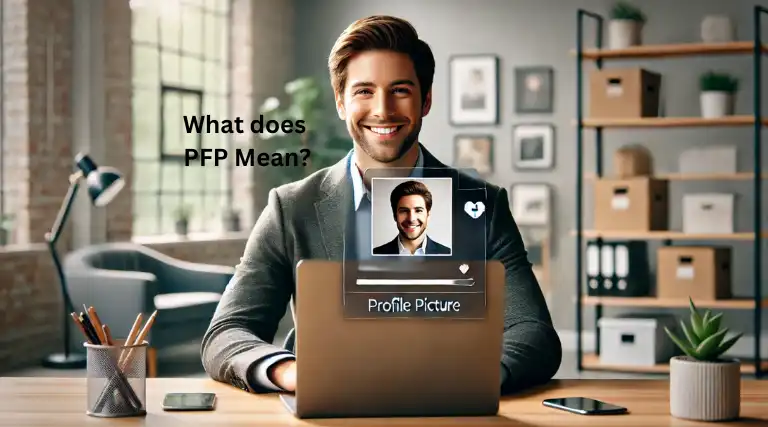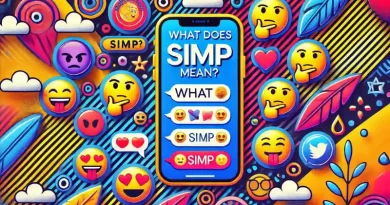PFP Meaning: Best Practices for Personal and Business Profile Pictures 📸
In today’s digital world, where first impressions are often made online, your profile picture (or PFP) is super important! It’s like your visual handshake—whether you’re building your personal brand or representing a business, having a standout PFP can make all the difference. So, let’s dive into everything you need to know about creating an impactful PFP that truly reflects who you are and engages your audience. 🙌
What Does PFP Mean? 🤔
You’ve probably seen the term “PFP” all over social media—on Facebook, X (formally Twitter), Instagram, you name it. But what does it actually mean? PFP is a text abbreviation that stands for “Profile Picture.” It’s that little image that pops up next to your username on your profile page. As social media platforms grew, so did the need for a quick and easy way to refer to these profile pics, and voilà, “PFP” was born! Now, it’s a term you’ll find in almost every online conversation.
A Quick Look at the Origin of PFP 📅
The acronym “PFP” really took off around the time Instagram was launched in July 2010. Back then, Instagram started as a simple photo-sharing app, but it quickly became a global sensation. And with the rise of social media, people needed a snappy way to talk about their profile pictures—thus, PFP became the go-to term. Fun fact: PFP can also stand for “Picture For Proof,” especially when someone wants visual confirmation of something. Pretty versatile, right?
Related Terms You Should Know 🧐
- DP (Display Picture): This is basically the same as PFP. It’s just another way to refer to the image that represents you on social media.
- Avatar: An avatar is a type of PFP, but it’s often a stylized or cartoon version of yourself instead of a real photo. Think of it as your digital alter ego! 💁♀️
- Selfie: Ah, the selfie—a quick self-portrait taken with your phone. Selfies make great PFPs because they’re personal and candid, perfect for adding a personal touch to your profile.
The Psychology Behind a Great Profile Picture 🧠
Did you know that your profile picture can influence how others perceive you—even beyond just how you look? The psychology behind a great PFP is fascinating! For example, studies have shown that people who smile in their profile photos are perceived as more approachable, trustworthy, and even happier in real life. 🥰
Smiling in your PFP isn’t just about looking friendly; it’s about building connections. According to research, people who have bigger smiles in their profile pictures tend to have better social relationships. So next time you’re choosing a PFP, think about how your expression can impact your digital presence. Whether it’s a warm smile or a confident look, your expression plays a big role in making your profile picture stand out.
Why Your Profile Picture Matters for Personal Branding 🌟
Your PFP is way more than just a photo—it’s a huge part of your personal branding strategy! In a world where first impressions often happen online, your profile picture is your chance to visually communicate your personality, style, and professionalism. It’s what makes people stop scrolling and want to connect with you.
Expressing Your Personality ✨
Your PFP is a reflection of who you are, so why not let your personality shine? Whether you go for a professional headshot or a more laid-back, casual pic, your profile picture should say something about you. It’s your way of showing the world what you’re all about, whether it’s in a personal or professional context.
Building Trust and Credibility 🤝
Consistency is key! Using the same PFP across all your social media platforms builds trust and makes you more recognizable. Think of it like your personal logo—people will start to associate that image with you, which is super important for networking and building your personal brand.
Profile Picture Dimensions and Optimization 📐
Every social media platform has its own guidelines for profile picture sizes, and getting it right is crucial for making a strong impression. Here’s the lowdown on what you need to know:
- Facebook: 170×170 pixels on desktops, 128×128 pixels on smartphones.
- Instagram: 110×110 pixels.
- Twitter: 400×400 pixels.
- LinkedIn: 400×400 pixels.
But here’s the thing: you don’t need to stress about creating a different size for every platform. A good rule of thumb is to stick with a 400×400 pixel image. This size meets the requirements for most platforms and ensures your PFP looks sharp and clear, whether it’s displayed in a square or cropped into a circle.
Another tip? Always save your PFP as a PNG file with 99% opacity. This little trick helps avoid the dreaded blurriness that can sometimes happen after uploading your photo.
Why Profile Pictures Are Crucial for Business Branding 💼
If you’re running a business, your profile picture is a big deal. It’s not just about looking good; it’s about representing your brand in the best way possible. For businesses, the PFP is often a logo or some other visual element that embodies the brand’s identity.
Consistency Across Platforms 🔄
Just like with personal branding, consistency is vital in business branding. Using the same PFP across all your social media channels ensures that your brand is easily recognizable and visually cohesive. This helps reinforce your brand image and makes it easier for customers to find you online.
Enhancing Professionalism 💼
A professional and well-designed PFP can boost your business’s credibility. Whether it’s a sleek logo or a polished image, a quality PFP tells your audience that you’re reliable and competent—qualities that are essential for attracting and keeping customers.
How to Create a Standout Profile Picture 📸
Creating a PFP that pops isn’t just about snapping a good photo—it’s about crafting an image that perfectly represents your personal or business brand. Here’s how to make sure your PFP stands out:
1. Choose the Right Setting 🌄
For personal profiles, pick a background that reflects your personality. Love the outdoors? Snap a pic in a park. For business profiles, a clean, professional backdrop is your best bet.
2. Focus on Lighting 💡
Natural light is your friend! It gives your photo a soft, flattering glow. Avoid harsh lighting or shadows, which can make your pic look less polished.
3. Dress Appropriately 👗
For professional headshots, go with attire that matches your industry’s standards. For more casual social media profiles, wear something that shows off your personal style.
4. Maintain Good Posture 🧍♀️
Stand or sit up straight—it conveys confidence and approachability. A relaxed yet upright posture makes your PFP more engaging.
5. Use a Quality Camera 📷
If you can, use a good camera or a smartphone with a high-res camera. A clear, sharp image is key to making a great impression.
6. Be Authentic ✨
Authenticity is everything. Choose a PFP that genuinely represents who you are or what your brand stands for. It’s all about being real and relatable.
7. Update Regularly 🔄
Keep your PFP fresh! Regular updates ensure that your picture always reflects your current look or brand identity.
Common Mistakes to Avoid 🚫
Just as there are things you should do to create a great PFP, there are also some pitfalls to avoid. Here are a few common mistakes:
- Using Outdated Photos: Make sure your PFP is up-to-date. If it’s been a few years since you took that profile picture, it’s time for a new one.
- Poor Lighting: Avoid dark or overly bright lighting. You want to be clearly visible without harsh shadows or glare.
- Distracting Backgrounds: Your face should be the focus, so choose a background that doesn’t steal the spotlight.
- Inappropriate Attire: Your outfit should match the platform. A professional look for LinkedIn, and maybe something more casual for Instagram.
- Looking Away from the Camera: Eye contact builds connection. Don’t miss the chance to engage with your audience by looking away.
Testing Your Profile Picture for Maximum Impact 📊

Here’s how it works: Upload a few different versions of your PFP, and let the community vote on them. You’ll receive scores and comments that can help you choose the most effective photo. It’s like having a mini focus group, and it’s especially useful if you’re trying to decide between a few different pictures.
Incorporating Brand Elements into Your PFP 🎨
For those looking to align their personal or business PFP with their brand, incorporating brand elements into your profile picture can be a subtle yet powerful way to reinforce your identity. Here are some ideas:
- Wear Your Brand Colors: If your brand has specific colors, consider wearing an outfit that includes these shades.
- Use a Branded Background: A simple background in your brand’s colors can add a cohesive look to your PFP.
- Include a Small Logo: If there’s room, adding a mini version of your logo to the corner of your PFP can be a great touch, particularly for business profiles.
- Reflect Your Brand’s Personality: If your brand is creative, fun, and vibrant, make sure your PFP reflects that energy. If it’s more serious and professional, your PFP should convey that tone as well.
However, a word of caution: Avoid using just a logo as your profile picture unless you’re a large, well-established brand. People connect with faces, not logos, so whenever possible, keep your PFP human and personable.
DIY Tips for Taking Your Own PFP 📸
Not everyone has access to professional photographers, but that doesn’t mean you can’t create a stunning PFP on your own! Here are some DIY tips to help you capture a great profile picture:
- Use Natural Light: Stand near a window or go outside to take advantage of natural light. It’s soft, flattering, and helps to avoid harsh shadows.
- Keep the Background Simple: A plain or uncluttered background ensures that the focus stays on you. You don’t want your background to distract from your face.
- Dress for the Occasion: Choose clothing that aligns with the image you want to project. If it’s a professional profile, go for something business-appropriate. For casual profiles, feel free to show off your personal style.
- Find the Right Angle: The camera should be at or slightly above eye level. Avoid extreme angles that can distort your features.
- Take Multiple Shots: Don’t settle for the first picture you take. Experiment with different poses, expressions, and angles. Then, choose the best one from the bunch.
With these tips, you can create a professional-looking PFP that doesn’t break the bank.
Monitoring and Updating Your PFP 🔄
Your profile picture isn’t something you should set and forget. It’s important to monitor how it performs over time and update it as needed. Here are some tips for managing your PFP:
- Monitor Engagement: Keep an eye on how people are responding to your PFP. If you notice a drop in engagement or if people seem to have trouble recognizing you, it might be time for an update.
- Stay Current: Update your PFP regularly to reflect any changes in your appearance or brand. A current photo helps others recognize you and keeps your online presence fresh.
- Test New Images: If you’re thinking about changing your PFP, consider testing new images to see how they perform before making the switch.
Tips for Managing Your PFP 🛠️
Once you’ve nailed your PFP, here’s how to keep it effective:
- Consistency Across Platforms: Stick to the same PFP on all your social media accounts to make sure people recognize you or your brand easily.
- Role in Online Communities: In some online communities, having a recognizable PFP is crucial for building trust and maintaining your identity.
- Monitor Image Performance: Pay attention to how your PFP is performing. If engagement drops, it might be time for an update.
Other Meanings of PFP 🤷♀️
While PFP is most commonly known as “Profile Picture,” it can also stand for a bunch of other things depending on the context. Here are a few:
- Partnership For Peace
- Personal Financial Planning
- Pay For Performance: In healthcare, this is a model where providers are paid based on the quality of care they provide.
- Printer Friendly Page
- Personal Financial Planner
- People Funding People
- Panel For Peace
Conclusion: Your Profile Picture Matters More Than You Think! 🎯
Your profile picture is one of the first things people notice about you online, whether you’re networking professionally, engaging with friends, or building your brand. It’s more than just a snapshot—it’s a powerful tool that conveys your personality, credibility, and the essence of who you are or what your brand represents.
From choosing the right setting and lighting to understanding the psychology behind your expression, there’s a lot that goes into creating a standout PFP. But don’t worry, with the tips and best practices outlined in this guide, you’re well-equipped to create a profile picture that not only looks great but also resonates with your audience.
Remember, your PFP isn’t something you should set and forget. Keep it fresh, authentic, and consistent across platforms to ensure you’re making the best possible impression every time someone comes across your profile.
So, go ahead—take that perfect shot, update your PFP, and let it work its magic! 📸✨
Frequently Asked Questions and Answers
PFP stands for “Profile Picture,” a key visual element on social media platforms. It’s important because it represents your personal or business brand and is often the first impression you make online.
Choose a picture that reflects your personality or brand, use good lighting, and ensure it’s high-quality. A consistent, clear image helps you stand out and be easily recognized.
good rule of thumb is to use a 400×400 pixel image, which works well across most platforms like Instagram, LinkedIn, and X (formally Twitter), ensuring your PFP looks sharp and clear.
Avoid using outdated photos, poor lighting, distracting backgrounds, and inappropriate attire. Ensure your PFP is clear, professional, and aligns with the platform’s context.
Use natural lighting, a simple background, and a high-quality camera or smartphone. Take multiple shots, and choose the one that best represents your personality or brand.








